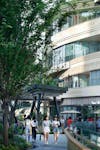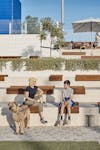To be an urban designer is to lift your eyes from the design of a singular place or object. Instead, we consider all the systems that make urban life possible and weave these together of so that they work together in a complementary way.
While the thinking is expansive, the application of urbanism is not limited to large-scale projects. The smallest sites can benefit from a thoughtful examination of the historical context, the movement of people and goods, the local ecology, the threat of sea level rise, changes in demographics, down to the arrangement of sewerage services underfoot.
Urbanism & urban design
We are students of the city.
The result is a strategy that can generate both big, impactful design features as well as smaller, fine-grain details that, regardless of their size, are consistent in their adherence to that plan.
ASPECT Studios engages with urbanism in a “ground-up” way – a counterpoint to the top-down flavour of design that begins with a monolithic design idea and contorts the site to fit it. Instead, we start with our feet on the site and our gaze cast toward the skyline so that we can begin to understand and appreciate the physical and emotional experience of a place.
The outcome of this thinking can vary from large-scale urban plans and feasibility assessments, to strategies for street trees and pedestrian connections.
ASPECT Studios engages with urbanism in a “ground-up” way – a counterpoint to the top-down flavour of design that begins with a monolithic design idea and contorts the site to fit it. Instead, we start with our feet on the site and our gaze cast toward the skyline so that we can begin to understand and appreciate the physical and emotional experience of a place.
The outcome of this thinking can vary from large-scale urban plans and feasibility assessments, to strategies for street trees and pedestrian connections.



Yagan Square
At its core, urbanism is a way of solving problems. An urbanist’s approach is as much to question what a site is, as much as it is to question what it will look like - and good design can only meaningfully take place when those questions are answered.
In practicing this kind of urbanism, designers at ASPECT Studios aren’t limiting themselves to the singular discipline of landscape design. Our work is inflected with thinking about economics, construction, culture, history, ecology, transport planning and human behaviour.
With this expansive approach we are aiming for the creation of not only a good place, but good results for all the residents of the city.
In practicing this kind of urbanism, designers at ASPECT Studios aren’t limiting themselves to the singular discipline of landscape design. Our work is inflected with thinking about economics, construction, culture, history, ecology, transport planning and human behaviour.
With this expansive approach we are aiming for the creation of not only a good place, but good results for all the residents of the city.
Our work
Prahran Square created much-needed public space in a dense Melbourne neighborhood by resolving a series of thorny urban challenges.
The Urban Gallery at Hyperlane sews together Chengdu's student quarter with the surrounding city, creating both a lively social space and a piece of urban connective tissue.
Darling Square transformed a previously isolated stretch of central Sydney into a place of integrated and vibrant public life.
The Urban Gallery at Hyperlane sews together Chengdu's student quarter with the surrounding city, creating both a lively social space and a piece of urban connective tissue.
Darling Square transformed a previously isolated stretch of central Sydney into a place of integrated and vibrant public life.











